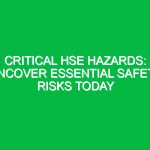Welcome to Today’s Toolbox Talk
Hello Team,
Today, we’ll focus on an essential topic that affects all of us in the workplace: Back Protection Safety. Back injuries are some of the most common workplace injuries, and they can lead to significant pain, suffering, and lost workdays. As we prepare to start our tasks today, it’s crucial to understand how we can prevent these injuries and ensure a safe working Environment.
Understanding Back Protection Safety
Back Protection Safety is about protecting our backs while performing various tasks. The back is a complex structure of bones, muscles, tendons, and ligaments that work together to support our body. When we exert ourselves, lift heavy objects, or even sit for prolonged periods without proper support, we risk injuring this vital part of our anatomy. Let’s explore some key aspects of Back Protection Safety that will help us minimize risks on the job.
Common Causes of Back Injuries
Back injuries can occur due to various reasons, including:
- Improper Lifting Techniques: Many injuries occur when employees lift heavy objects without using their legs and core muscles.
- Repetitive Motion: Performing the same action repeatedly, such as bending or twisting, can lead to strain over time.
- Poor Posture: Sitting or standing incorrectly can put excessive strain on the back.
- Slips, Trips, and Falls: Hazards in the workplace can lead to sudden movements that cause injuries.
Importance of Back Protection Safety
Maintaining proper Back Protection Safety is essential for several reasons:
- Preventing Injuries: Proactive measures can significantly reduce the risk of back injuries.
- Enhancing Productivity: Healthy employees are more productive. Reducing downtime due to injuries means more efficiency.
- Improving Morale: A safe workplace fosters a culture of care and responsibility, which boosts morale.
- Reducing Costs: Fewer injuries lead to lower medical costs and compensation claims, benefiting both employees and the organization.
Best Practices for Back Protection Safety
Now that we understand the importance of Back Protection Safety, let’s discuss some Best Practices to follow:
1. Use Proper Lifting Techniques
When lifting heavy objects, always remember the following:
- Plan Your Lift: Assess the load and the path you will take. Make sure the area is clear of obstacles.
- Get a Good Grip: Use both hands and ensure you’re holding the object securely.
- Bend Your Knees: Squat down to lift with your legs rather than bending at the waist.
- Keep the Load Close: Hold objects as close to your body as possible to reduce strain.
- Don’t Twist: Avoid twisting your body while lifting. Instead, turn your whole body by moving your feet.
2. Use Equipment and Tools
Whenever possible, use equipment designed to reduce the strain on your back:
- Forklifts and Pallet Jacks: Use machinery to lift and move heavy loads instead of doing it manually.
- Hand Trucks: Utilize hand trucks for transporting multiple items.
- Ergonomic Tools: Invest in tools that are designed to minimize strain on your back.
3. Maintain Good Posture
Whether standing or sitting, good posture is crucial:
- Sitting: Ensure your chair supports your lower back. Keep your feet flat on the floor, and your knees at a right angle.
- Standing: Keep your weight evenly distributed on both feet and avoid locking your knees. Use a footrest if standing for long periods.
4. Take Frequent Breaks
Taking breaks is essential for preventing fatigue and strain:
- Stretch: Incorporate stretching into your routine to relieve muscle tension.
- Change Positions: Switch between sitting and standing to avoid prolonged stress on any part of your back.
5. Stay Fit and Healthy
Physical fitness plays a key role in Back Protection Safety:
- Strength Training: Strengthen your core and back muscles to support your spine better.
- Stay Active: Regular exercise improves flexibility and reduces the risk of injury.
Recognizing Hazards
It’s vital to identify and address potential Hazards in our workplace:
- Cluttered Walkways: Keep work areas tidy to prevent slips, trips, and falls.
- Improperly Stored Equipment: Ensure that tools and materials are stored safely to avoid having to lift awkwardly.
- Inadequate Training: Make sure everyone is trained in proper lifting techniques and back Safety Measures.
Real-Life Scenarios
Let’s consider some hypothetical scenarios that highlight the importance of Back Protection Safety:
- Scenario 1: Imagine an employee who routinely lifts boxes without proper technique. Over time, they develop chronic back pain, which leads to frequent absences. If they had followed proper lifting techniques, this could have been prevented.
- Scenario 2: Picture a worker who is tasked with moving heavy equipment without any assistance. They decide to do it solo, twisting their body awkwardly, resulting in a back injury. If they had used a team lift or equipment, this could have been avoided.
Regulations and Standards
Understanding regulatory standards can help reinforce the importance of Back Protection Safety:
- OSHA Regulations: The Occupational Safety and Health Administration (osha) provides guidelines to ensure safe lifting practices.
- Company Policies: Familiarize yourself with our organization’s policies on labor practices, ergonomics, and Workplace Safety.
Compliance with these regulations not only protects you but also the organization from legal liabilities.
Open Discussion
Now, I’d like to open the floor for discussion. Do any of you have experiences or tips related to Back Protection Safety that you’d like to share? Have you encountered any challenges in maintaining Back Safety in your role? Your insights could help us all learn and improve our practices.
Conclusion
To wrap up our Toolbox Talk, remember that Back Protection Safety is not just a personal responsibility but a collective effort. By following the Best Practices we discussed today, recognizing hazards, and looking out for one another, we can create a safer work environment for everyone.
Thank you all for your attention and commitment to safety. Let’s put these practices into action and keep our backs healthy!


